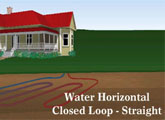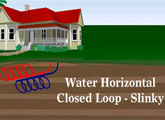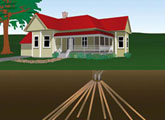Geothermal Designs
Our geothermal systems are uniquely designed to fit into your yard and home
When you work with Buschurs Refrigeration to build your geothermal system, we’ll design the perfect fit for your home and yard. Each system is specifically calculated for your needs.
Which geothermal design is right for you?
There are two basic geothermal designs to choose from:
- Open loop geothermal
- Closed loop geothermal.
A closed loop design utilizes a tubing heat exchanger called a ground loop, which may be installed horizontally or vertically below the earth’s surface.
Every geothermal system circulates refrigerant through the inside heat exchanger built into the geothermal unit which typically sets inside your house to transfer the heat from the ground into the air. But for closed loop geothermal designs there are also two basic types of fluids used in the ground loop heat exchanger.
- Water & Antifreeze solution
- Refrigerant (Freon)
One of these loop fluids circulate through the ground loop tubing, absorbing the heat from the ground. Geothermal systems offer many advantages such as: energy efficiency, cost savings, and environmental benefits.
Waterless™ Direct Exchange (DX) Vertical Loop Geothermal
A Waterless™ DX heating and cooling geothermal system is considered the most advanced because it does NOT use any water or plastic tubing as a ground heat exchanger. Instead a Waterless™ DX geothermal design uses only refrigerant and a highly conductive and more reliable copper ground loop. The Waterless™ design only requires a 3 foot circle. It has the least impact on the yard of all the ground loop designs. The copper loop comes complete with a lifetime warranty.
Vertical Loop Geothermal

A Vertical loop design is typically used when you want to achieve a greater efficiency or when space is limited. Your yard isn’t torn up nearly as much with a vertical loop design. The loop is installed using a drilling rig, and a pair of plastic pipes with special u-bend fittings which are inserted into the ground. A typical home requires three wells approximately 210 feet deep. A Water/Antifreeze solution circulates through the plastic tubing absorbing the heat from the ground.
When you want the maximum geothermal efficiency or your property is on a small section of land, a vertical loop geothermal system is what you’re looking for.
A vertical loop geothermal heating system utilizes a network of sealed and pressurized plastic pipes that are drilled vertically into the ground. Vertical loops are used primarily when you want to achieve the maximum energy efficiency and/or where land is limited. The plastic tubing is inserted into a borehole that averages between 150 to 300 feet deep. The ground temperature at this depth remains a constant 55 degrees year round.
The lengths and number of loops required is determined by the size and insulation/windows (along with other heat loss factors) of the home. To better understand the benefits of a vertical geothermal heating system, sign up for our free report on geothermal heating and cooling.
Horizontal Loop Geothermal
 Horizontal Loops are installed in areas where the soil conditions allow for economical excavation. Taking up more land than any other loop design, a horizontal loop can be installed when space permits it.The ground loop consists of a plastic pipe heat exchanger. A Water/Antifreeze solution circulates through the plastic tubing absorbing the heat from the ground.
Horizontal Loops are installed in areas where the soil conditions allow for economical excavation. Taking up more land than any other loop design, a horizontal loop can be installed when space permits it.The ground loop consists of a plastic pipe heat exchanger. A Water/Antifreeze solution circulates through the plastic tubing absorbing the heat from the ground.
A water geothermal horizontal loop system utilizes a network of sealed and pressurized plastic pipes that are buried into the ground horizontally, just below the earth’s surface. A Horizontal loop is typically buried 3-5 ft deep and at a length of 500 to 600 feet per ton. A typical home requires 1/4 to 3/4 of an acre for the trenches. The ground loop is a key component of the ground source water geothermal system. Therefore, many design factors need to be considered to ensure the proper installation of a horizontal loop system, be sure to ask your contractor about the design parameters considered for your geothermal loop.
Pond Water Loop Geothermal

If your home is close to a large size body of water, a plastic loop heat exchanger can be installed in the pond water (rather than soil). Installing a plastic loop in the pond is an option that is typically considered if you live in a moderate climate zone. The geothermal pond loop system utilizes the heat stored in a large body of water, such as a lake or a pond. A Water/Antifreeze solution circulates through the plastic tubing submerged in the pond water absorbing the heat from the temperature of the water. A series of loops can be coiled and sunk to the bottom. A 1/2 acre, 14-foot-deep pond is usually sufficient enough for the average home. The deeper the pond, the less fluctuation in water temperature during extreme outside temperatures. Very little excavating is necessary when installing a pond loop. A loop design is especially critical with a pond loop system which can lead to system problems if not given proper consideration. Be sure to discuss the loop design of your project with your contractor before starting your project.
Open Loop Geothermal

An open loop system system is typically installed in rural areas where it can utilize the 55 degree well water as the heat source for you home. Typically it does not require any outside digging. An open loop geothermal system pumps water from the existing water well through the geothermal unit where the heat is removed from the water. After removing the heat from the water, it remains clean and can be discharged to multiple locations such as: to a running stream, pond, or down a drain. This system typically requires more future maintenance than a closed loop system so be sure to discuss any future maintenance considerations with your contractor.
When you live in a rural location with a well, and you don’t have space to bury a ground loop, an open loop geothermal system is one you may want to consider. An open loop geothermal heating system utilizes the earth’s natural heat stored in the ground water deep below the earth’s surface. Open loop geothermal systems are ideally suited for homes that have existing water wells available or a good potential source for well water.
Open loop geothermal heating systems draw heat from the 55 degree well water during the heating and cooling mode. Since ground water temperatures remain very constant throughout the year, despite wide variations in the outside air temperature, your geothermal heating and cooling unit is capable of maintaining its efficiencies no matter how hot or cold it is outside.
The water is pumped from your well into the geothermal unit located inside the house. The water is ran through a heat exchanger which transfers the heat from the 55 degree water into the refrigerant circulating in the geothermal heating system.
The heated refrigerant is then sent to a radiator coil which in turn transfers the heat into the air that is distributed throughout the ductwork. During the air conditioning mode, the system provides cool, dry air to your home. Water hardness, a high iron count and other impurities in the water can increase the frequency of service calls and have a dramatic impact on the life expectancy of an open loop geothermal. When groundwater is available, this system usually has the lowest installation cost.
Slinky Loop Geothermal

The Slinky loop design is another horizontal closed loop design. This design can save space requiring less land area and shorter trenching when considering installing a horizontal slinky loop. The plastic heat exchanger pipes are typically laid flat in a circular pattern at the bottom of a trench. A Water/Antifreeze solution circulates through the plastic tubing absorbing the heat from the ground. The slinky loop design is typically buried 3-6 ft deep. The plastic ground loop heat exchanger is typically laid flat in a circular pattern at the bottom of a trench. A water/antifreeze solution circulates through the plastic tubing absorbing the heat from the ground.
Other design factors should be considered with a slinky loop system, so be sure to ask your contractor about the loop design parameters.


